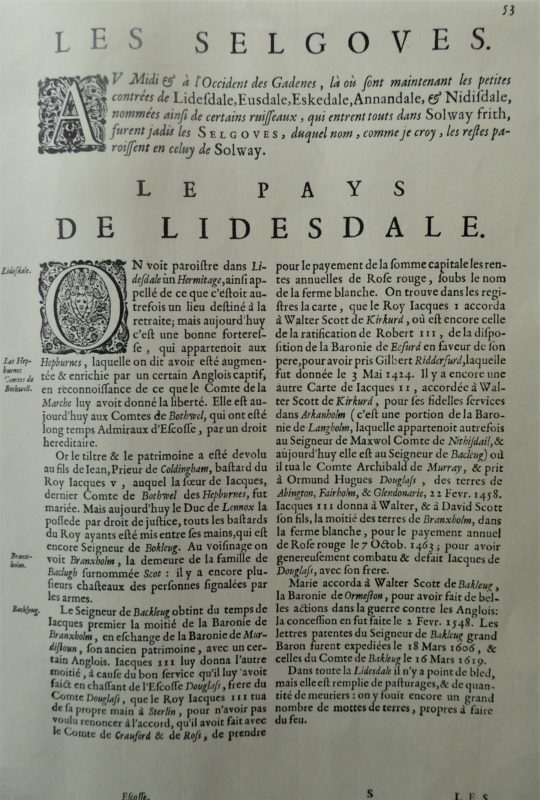Galloway description 1654 "The inhabitants engage in fishing both in the surrounding sea and in…
Liddesdale Description from Blaeu Atlas 1654
Liddesdale Description 1654
 In Liddesdale rose up Hermitage, so called because it will at one time have been dedicated to the solitary life; but now it is a well-fortified castle, which belonged to the Hepburns; they trace their origin to an English prisoner, whom the Earl of March enriched because he had freed him from danger. They were Earls of Bothwell and for long by hereditary right Admirals of Scotland.
In Liddesdale rose up Hermitage, so called because it will at one time have been dedicated to the solitary life; but now it is a well-fortified castle, which belonged to the Hepburns; they trace their origin to an English prisoner, whom the Earl of March enriched because he had freed him from danger. They were Earls of Bothwell and for long by hereditary right Admirals of Scotland.
The National Library of Scotland website contains Blaeu Atlas of Scotland 1654 with this text based on text from Timothy Pont and Robert Gordon and from Camden: Britannia 1607
SELGOVAE
Below the Gadeni to the south and west, where are now the sub-regions of Liddesdale, Ewesdale, Eskdale, Annandale and Nithsdale, named from the small rivers flowing through them, which all bury themselves in the Solway Firth, once were settled the Selgovae, the remains of whose name seem to me, if not to others, to survive in that name of Solway.
LIDDESDALE
In Liddesdale rose up Hermitage, so called because it will at one time have been dedicated to the solitary life; but now it is a well-fortified castle, which belonged to the Hepburns; they trace their origin to an English prisoner, whom the Earl of March enriched because he had freed him from danger. They were Earls of Bothwell and for long by hereditary right Admirals of Scotland.
Now by the marriage of a sister of James Earl of Bothwell, the last of the Hepburns, to John Prior of Coldingham, a natural son of King James V (who sired exceedingly many bastards), both title and patrimony came to his son. Now the Duke of Lennox owns them, for by forfeiture of the bastard himself they came into the hands of the King, and the Lord is now Buccleuch. Nearby is Branxholm, home of the warlike family of Buccleuch of the name of Scot, and around are many small towers of military men.
Half of this barony of Branxholm was held by the Lord of Buccleuch in the time of James I by exchange of the barony of Murdistoun his ancient patrimony from a certain Inglis. The other half was given to him by James III because of faithful service in driving out of Scotland the Douglas brother of the Earl of Douglas, whom James III stabbed with his own hand at Stirling, because he refused to renounce the treaty between him and the Earl of Crawford and Ross, to be held in chief for payment of a red rose yearly in blanchfarme. There is found in the register a charter of Walter Scott of Kirkurd granted by James I, where is included a ratification of a charter of Robert III, his father, concerning the disposition of the barony of Ecfurd for the seizing of Gilbert Rutherfurd, dated 3 May 1424.
Another charter of James II was granted to Walter Scott of Kirkurd for his faithful service at Arkanholme (it is part of the barony of Langholm, which once belonged to Lord Maxwell, Earl of Nithsdale, now to Lord Buccleuch by purchase), where Archibald Earl of Moray was killed and Hugh Douglas Earl of Ormond was captured, of the lands of Abington, Fairholm and Glendonarie, 22 February 1458. James III granted to Walter and David Scot his son for their strong and faithful work given in attacking and defeating James Douglas and his brother, half of the lands of Branxholm, in blanchfarme, for payment of a red rose yearly, 7 October 1463.
Mary granted to Walter Scot of Buccleuch the barony of Ormiston, because of distinguished deeds in war against the English, dated 2 Febr. 1548. The diploma of the Lord of Buccleuch as greater baron is dated 18 March 1606. The diploma of the Earl of Buccleuch is dated 16 March 1619.
In Liddesdale there are no cornfields, all is pasture and moorland, which we call fens, land suited for digging turfs for the hearth.
